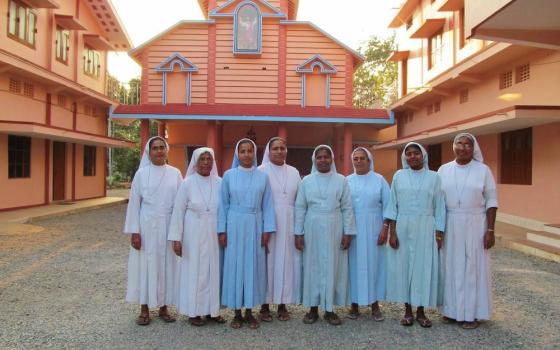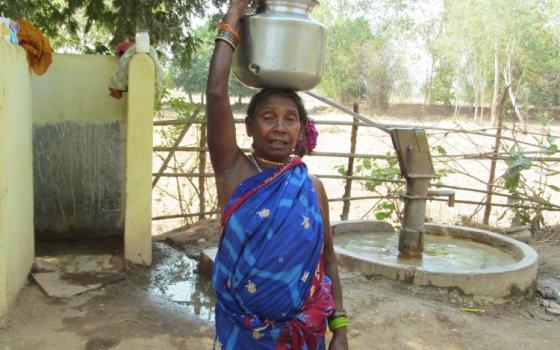Although I began my journalism career some 20 years ago, my toughest assignments came in the past year while covering the activities of some Catholic religious women for Global Sisters Report.
The nuns work mostly in central and eastern India, where Maoists, locally known as Naxalites, operate, positioning themselves as saviors of tribal and low-caste villagers, devastated after years of abuse and subjugation by landlords and government officials. The term comes from Naxalbari, a village in West Bengal state in eastern India, where the Maoist-inspired movement began in 1967. Most Naxalite leaders are educated urban youth disillusioned with the unjust social system.
Reporting about these nuns was both challenging and unnerving, to say the least.
My first stint was in the third week of February 2016 in the Bastar region of Chhattisgarh state in central India, where the sisters of Deen Bandhu Samaj (Society of the Friends of the Poor) work among illiterate tribal and lower-caste people.
Maoists entered Bastar in 1980 and, as they established their hold over the region, it became an important part of India's so-called Red Corridor, a contiguous area spanning eastern India and rife with illiteracy, poverty, exploitation and overpopulation.
It took two days of travel — by train, bus and cars — for me to reach Jagdalpur, the region's headquarters. But that was the easiest part of the assignment, I soon realized.
My contact in Jagdalpur, a Carmelite of Mary Immaculate priest, told me that as an outsider, I should not go alone to the inaccessible villages set deep inside forests where the nuns worked.
One of those villages was Gangaloor in Bijapur district, and another priest offered to take me there. Before setting out, the priest strictly told me not to use a camera or draw the attention of the paramilitary forces that guarded the 16-mile road from the district headquarters to the village.
Not far away, we saw the road barricaded and a police camp nearby. They let us go because the policemen were familiar with the priest's car.
We also found gun-toting policemen on motorbikes patrolling the road.
After a while, we entered the forest area, which looked deserted. I wanted to click a few photographs with the priest's permission. However, the plan had to be dropped as the watchful heads of policemen popped up from behind bushes and trees.
We also found policemen supervising laborers repairing the road in several places. I wondered how a concrete road could be damaged at so many places.
The priest explained that it was the only road to Gangaloor and other villages in the forest. The Maoists, who are active in the area, often explode mines to block movement of the security personnel in the forest. The priest noted that the security men avoid traveling on the road after sunset.
I later learned that the Catholic priests and nuns working in those villages used the same road, sometimes at night.
At Gangaloor, I wanted to visit a few neighboring villages, but the convent superior explained the unwritten law there: "Outsiders are not permitted to go to the people." Both the security forces and the underground militants treat the outsider as a traitor. Anyone violating the informal ban could fall into the hands of one group or the other.
I was told the villagers avoid contact with outsiders because they fear trouble from the police as well as the insurgents.
My contacts also warned me that I would be in greater trouble if my journalist identity were revealed. I was shocked. In all the places I have traveled, that identity was what brought me respect and accessibility.
I had to interview only those villagers the nuns invited to their convent.
On my return to Jagdalpur, I took a bus from Bijapur and started a conversation with a person sitting beside me. When I asked about Maoists, he became suddenly quiet. After some time, he asked quietly if I was an outsider. When I nodded, he whispered, "Here, nobody utters the name of Maoists." He also made sure no one else heard us.
Later, when I asked some schoolchildren about the Maoist presence in their area, all I received was blank expressions. The sisters told me that people are scared because informers of both the police and the Maoists are active in villages.
Police will arrest anyone showing interest in the outlaws. The Maoists, on the other hand, recently did away with suspected police informers.
The villagers are caught between the devil and the deep sea, one of the sisters told me.
She was among more than 400 sisters and 90 priests who serve 3 million people in that volatile region. I found them rooted in the Gospel and in Catholic social teaching, which focuses on the dignity of every human being, the imperative to advocate against and correct social injustices, and the church's preferential option for the poor.
They teach traditional farmers modern agricultural techniques, manage schools and youth clubs, and encourage hundreds of help groups, most of them geared toward the needs of women. All this is to help the people who have lost their right to a dignified life and who live in fear and suspicion.
Another region, similar dangers
The situation was not different in Gumla region of Jharkhand state, Chhattisgarh's eastern neighbor that I visited in October.
I wanted to visit Rajawal parish to meet the family of Missionary of Charity Sr. Anselm Minj, who was killed in March a year ago in Yemen by the Islamic State militants.
I hired a car from Ranchi, the state capital, to travel the 125-mile distance. The driver suggested that I should stay back in the sisters' parish at night because travel was unsafe.
I told him I had to get back the same day. As the journey progressed, the driver gradually opened up. The area where we were going was one of the most dangerous places in Jharkhand, he said.
If anyone goes missing, no one will even search for the body, he said. It is presumed Maoists killed the person, and there is no chance of recovering the body.
Unlike in Chhattisgarh, I found the villagers in Jharkhand cordial and happy. However, there still was no talk about Maoists. I was warned that the Maoists would know about me from their informers even before I reached the village.
Another difference between Bastar and Gumla was the absence of paramilitary forces.
The villagers in Gumla are forced to follow the dictates of the outlaws. Of course, the Maoists would eliminate anyone they suspect to be a police informer.
People seemed familiar with outlaws, who keep visiting the villages for food and other needs. The Maoists oppose wide roads, electricity and cellphone facilities in the area, and the people hardly protest.
As it was getting late, the driver asked me to speed up my work.
He was a different man on the return trip. When we went to the village, he drove at a 30-mile-per-hour speed, but on the way back, the needle never dropped below 60 miles an hour. He looked tense and remained silent until we passed the area under Maoist control.
Despite the tension and worries, the reporting experience opened my eyes to the daily living conditions of the Catholic women who work for the downtrodden and marginalized in India.
I also found them organizing these hapless people to demand a better future in their own small ways, despite all odds.
I was told the missionaries too face challenges from the outlaws. However, they continue to work for the People of God. Witnessing this led me to reaffirm my faith in Christ.
Only that deep faith in Christ and commitment to spread his message of liberty and freedom keep the missionaries in Bastar and Gumla going.
[Saji Thomas is a freelance journalist based in Bhopal, a central Indian city. He has worked for several mainstream newspapers such as The Times of India.]




